

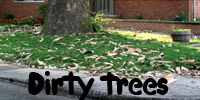
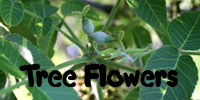
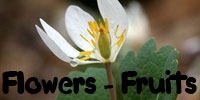
(Additional content at flickr Photostream and YouTube Channel)
If you have botany questions or comments please email BobK . Thanks!
Common Evergreen Conifers
Part 1: Pinaceae, the Pine Family
Part 1: Pinaceae, the Pine Family
When most people
think of
conifers, they think of pine (genus Pinus
in the family Pinaceae), although a spruce or fir is very likely to be
called a "pine tree" by somebody not yet familar with the fine points
of
plant identification. Pines are needle-leaved evergreens, the leaves of
which, except those of a Great Basin species aptly named Pinus monophylla, are bundled
together in sheathed fascicles of 2-5. There are only four native pines
in Ohio: shortleaf (P. echinata),
pitch (P. rigida), white (P. strobus), and Virginia pine (Pinus virginiana, also known as
"scrub pine").
Here along Rte 36/37 in Delaware County there are scattered rows of planted Virginia pines.
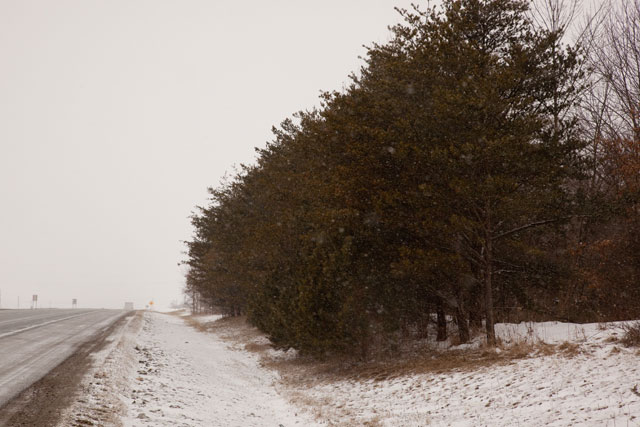
Roadside Virginia pines. February 26, 2010. Delaware, Ohio.
Ohio isn't rich in native conifers. Two northern genera in the Pinaceae that make it to nearby West Virginia --Picea (spruce) and Abies (fir) --are absent even though we have bogs in northeast OH and moderately high-altitude acid-soil areas in southern OH where it seems they could occur. Alas, they don't. Nonetheless, various European and western North American spruces are very abundant as lawn, park, and roadside ornamentals. Here's some kind of spruce at Greenlawn Cemetery in Columbus.
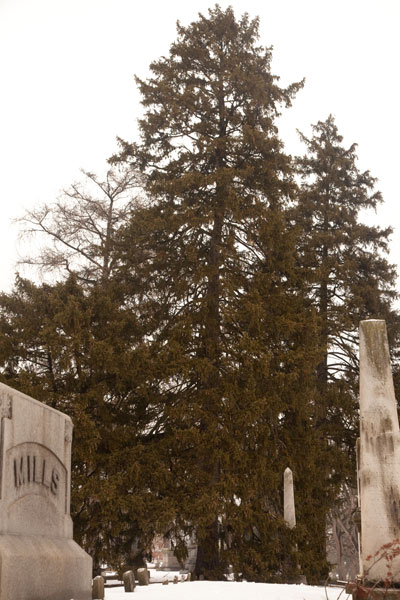
Ornamental spruce tree at Greenlawn Cemetery. Columbus, Ohio. February 22, 2010.
Here along Rte 36/37 in Delaware County there are scattered rows of planted Virginia pines.

Roadside Virginia pines. February 26, 2010. Delaware, Ohio.
Virginia pine seed cone
scales are distinctively spine-tipped. The leaves are short, and
bundled in twos.
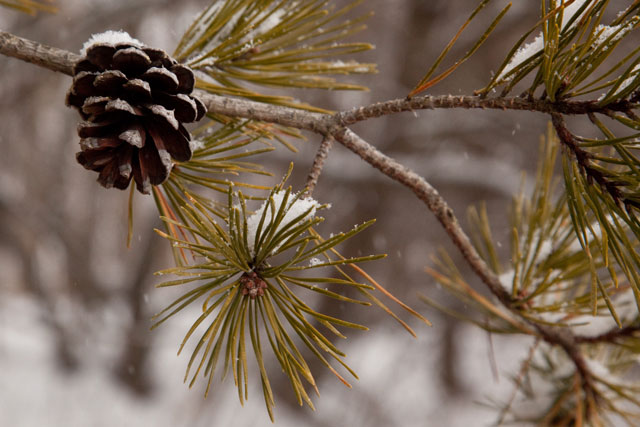
Virginia pine branch. February 18, 2010. Delaware County, Ohio.

Virginia pine branch. February 18, 2010. Delaware County, Ohio.
Closeup, it is evident that
the fascicled leaves are enveloped at their bases by a papery
sheath.
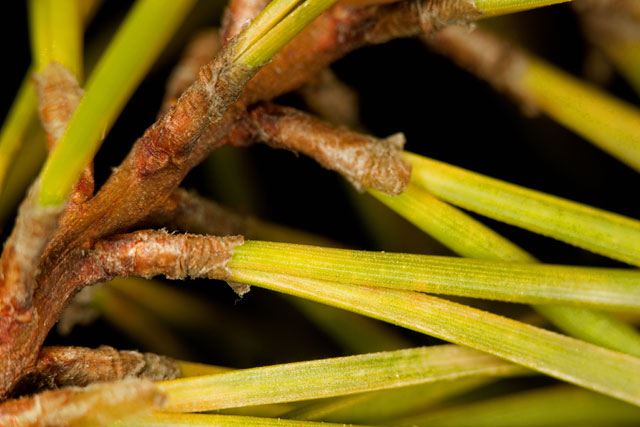
Virginia pine leaves are fascicled in pairs.

Virginia pine leaves are fascicled in pairs.
Ohio isn't rich in native conifers. Two northern genera in the Pinaceae that make it to nearby West Virginia --Picea (spruce) and Abies (fir) --are absent even though we have bogs in northeast OH and moderately high-altitude acid-soil areas in southern OH where it seems they could occur. Alas, they don't. Nonetheless, various European and western North American spruces are very abundant as lawn, park, and roadside ornamentals. Here's some kind of spruce at Greenlawn Cemetery in Columbus.

Ornamental spruce tree at Greenlawn Cemetery. Columbus, Ohio. February 22, 2010.
Spruces bear
their leaves singly.
The cones are pendant.
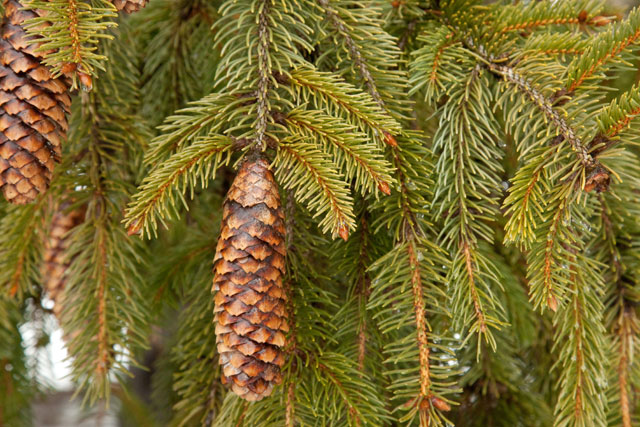
Branches of ornamental spruce tree at Greenlawn Cemetery, Columbus, Ohio. February 22, 2010.

Branches of ornamental spruce tree at Greenlawn Cemetery, Columbus, Ohio. February 22, 2010.
The
leaves of spruces are 4-sided, spreading off the
twig in all directions. Their bases are attached to, and lie
alongside, the twigs,
giving them a very rough appearance. The leaves are quite sharp (ouch!)
and smell somewhat cat pee-ey.
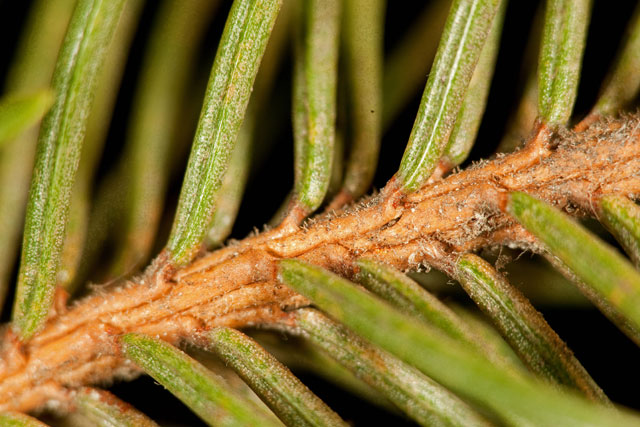
Spruce leaves are singly attached and the persitent bases give the twigs a rough appearance.

Spruce leaves are singly attached and the persitent bases give the twigs a rough appearance.
Another needle-leaved
conifer,
leaves attached singly, is fir (genus Abies).
Here is some type of fir growing as an ornamental on the OSU campus.
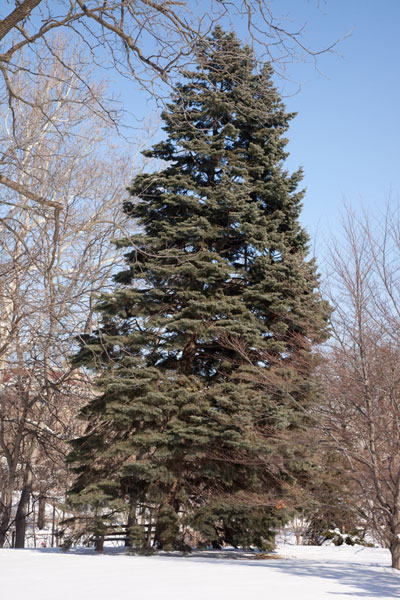
A fir tree on the OSU Columbus campus. February 19, 2010.

A fir tree on the OSU Columbus campus. February 19, 2010.
Fir
leaves are attached singly. Compared to those of spruce, fir leaves are
soft, flat, blunt, and sweet smelling. That pleasant "pine-needle"
sachet from the souvenir shop is probably a fir-neeedle sachet.
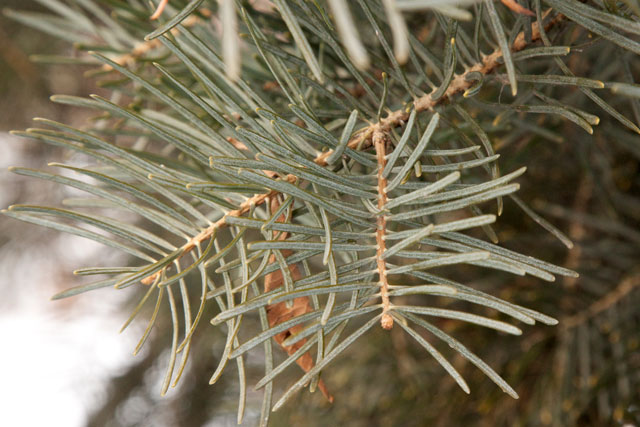
Branch of ornamental fir on the OSU campus. February 19, 2010.

Branch of ornamental fir on the OSU campus. February 19, 2010.
Fir twigs, in
contrast to those of
spruce, are smooth. Fir leaf bases are expanded, looking like little
suction cups.
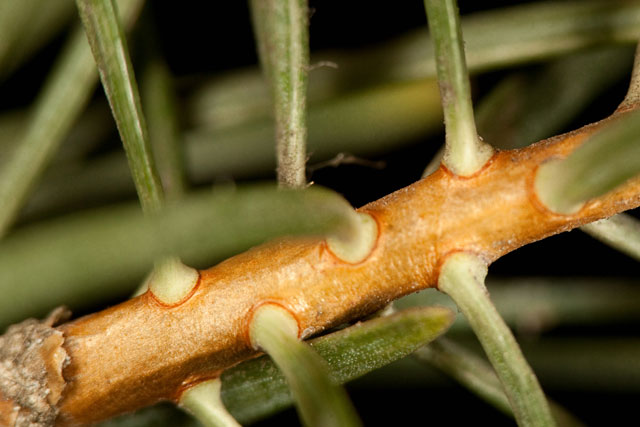
Fir twig.
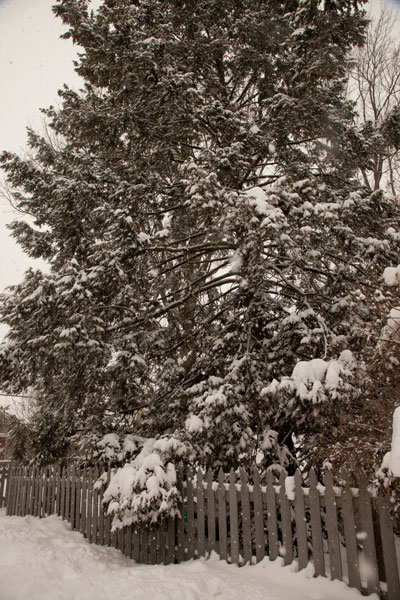
Eastern hemlock tree. February 15, 2010. Columbus, Ohio.

Fir twig.
Eastern hemlock, Tsuga
canadensis,
is a native Ohio member of the Pinaceae that is locally abundant in
cool
ravines in unglaciated southern portions of the state. It's also a
beautiful lawn
ornamental. Here's one in the Clintonville neighborhood of Columbus.

Eastern hemlock tree. February 15, 2010. Columbus, Ohio.
Eastern
hemlock leaves are flattened, and attached singly. The seed cone are
small. They ripen in autumn and release their seeds
during autumn and winter.
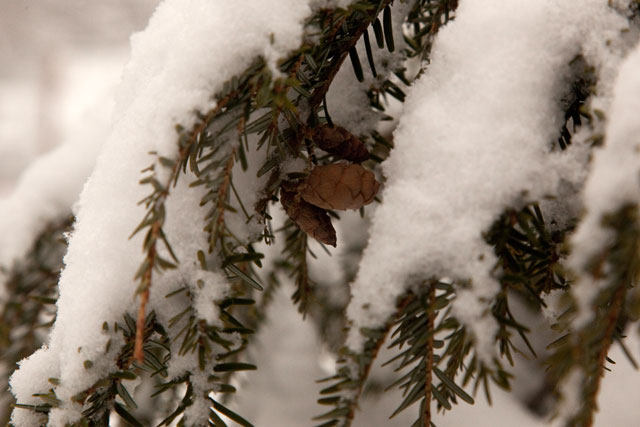
Eastern hemlock. February 15, 2010. Columbus, Ohio.

Eastern hemlock. February 15, 2010. Columbus, Ohio.
Eastern
hemlock leaves are
spirally arranged around the twig, but the upper and lower ones are
splayed sideways, resulting in flattened sprays of foliage. Prominent
paried white lines of stomates (breathing pores) mark the underside of
each leaf. Like those of spruce, eastern hemlock twigs have a rough
appearance owing to persistent leaf bases lying alongside the
twigs.
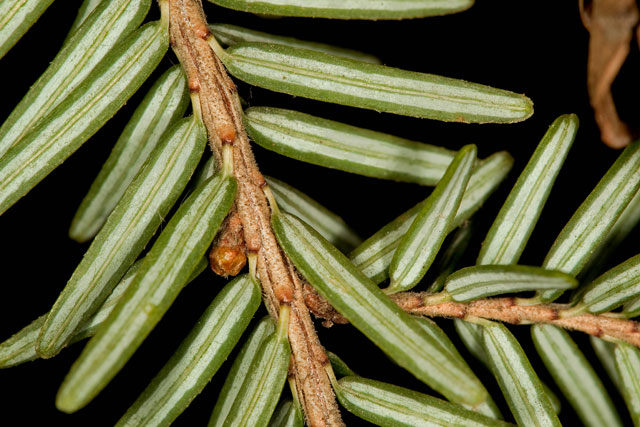
The remaining evergreen member of the Pinaceae is not an Ohio native. This is Douglas-fir, Pseudotsuga menzeisii, the massive tree, overtopped only by the redwoods, that dominates conifer forests of the Pacific northwest and Rocky Mountains. The species is planted sparingly in parks and cemeteries. Here's one at Greenlawn, pretty wimpy, but Douglas-fir nonetheless.
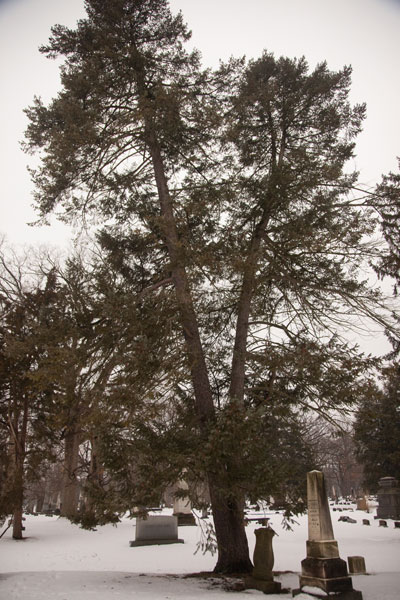
Douglas-fir at Greenlawn Cemetery. February 22, 2010.
Part 2: Cupressaceae, the Cypress family

Eastern hemlock twig.
The remaining evergreen member of the Pinaceae is not an Ohio native. This is Douglas-fir, Pseudotsuga menzeisii, the massive tree, overtopped only by the redwoods, that dominates conifer forests of the Pacific northwest and Rocky Mountains. The species is planted sparingly in parks and cemeteries. Here's one at Greenlawn, pretty wimpy, but Douglas-fir nonetheless.

Douglas-fir at Greenlawn Cemetery. February 22, 2010.
Eerily similar
both to spruce
(Picea) and fir (Abies),
and with a genus name meaning
"false hemlock,"
Douglas-fir can indeed be a fooler. Fortunately, a merciful
natural
selecter installed an easy identification module: seed cones
that are most distinctive. Doug-fir cones have very long appendages
(bracts) extending out above each of the woody seed-bearing scales. In
other
conifers, these bracts are so short as to be out of sight, obscured by
the scales. Pseudotsuga cone
bracts bear a whimsical resemblance to mice
crawling into the cones, with only their back legs and tail protruding.
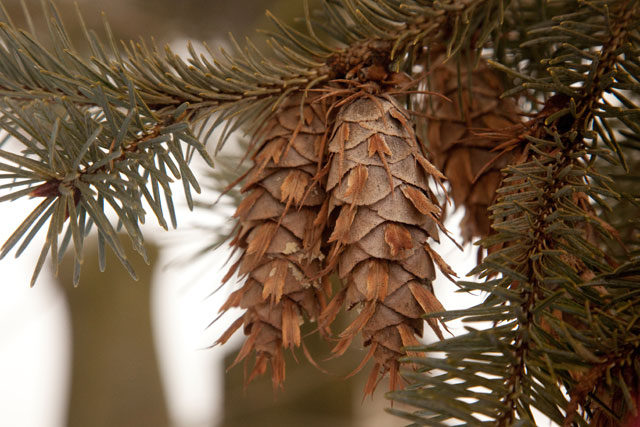
Douglas-fir at Greenlawn Cemetery. February 22, 2010.

Douglas-fir at Greenlawn Cemetery. February 22, 2010.
Douglas-fir leaves are
attached
singly and spirally inserted, thus the tree looks much like spruce or
fir. The
texture of the twigs is intermediate between the roughness of spruce
and the smoothness of fir.
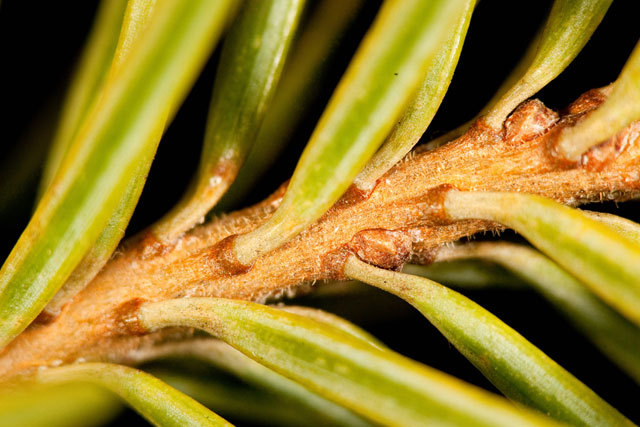
Douglas-fir leaves are singly attached, and spirally inserted on twigs that are a bit rough.

Douglas-fir leaves are singly attached, and spirally inserted on twigs that are a bit rough.
Part 2: Cupressaceae, the Cypress family
Members of the
Cupressaceae bear
small needle like or, more often, scale-like leaves that are opposite
or whorled, crowded and often overlapping. Of the three northeastern
U.S. genera, two occur naturally in Ohio: Thuja (northern whitecedar) and Juniperus (juniper). Missing is
a species of Chamaecyparis,
C. thyoides,
Atlantic whitecedar, that occurs on the coastal plain. Atlantic
whitecedar (spelled as one word because its really a cypress, not a
cedar) and
other species in the genus are cultivated ornamentals, so there must be
some Chamaecyparis lurking
about in Columbus but my efforts to track one down for this article
have failed.
Northern whitecedar (deliberately spelled as one word because it's really a cypress, not a cedar), found naturally in both wet fens and on dry limestone outcrops, is also a widely planted ornamental. Below, see planted whitecedars forming a semicircular backdrop of a little amphitheater on the OSU campus. (Note also the tallest tree in the backgound, a deciduous conifer, baldcypress (Taxodium distichum, family Taxodiaceae.)
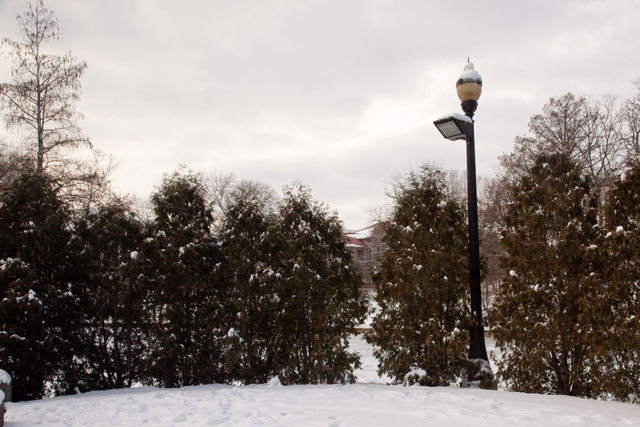
Northern whitecedar at OSU, Columbus, Ohio. February 7, 2010.
Northern whitecedar (deliberately spelled as one word because it's really a cypress, not a cedar), found naturally in both wet fens and on dry limestone outcrops, is also a widely planted ornamental. Below, see planted whitecedars forming a semicircular backdrop of a little amphitheater on the OSU campus. (Note also the tallest tree in the backgound, a deciduous conifer, baldcypress (Taxodium distichum, family Taxodiaceae.)

Northern whitecedar at OSU, Columbus, Ohio. February 7, 2010.
Thuja
produces little upright seed cones that are oblong, with overlapping
scales.
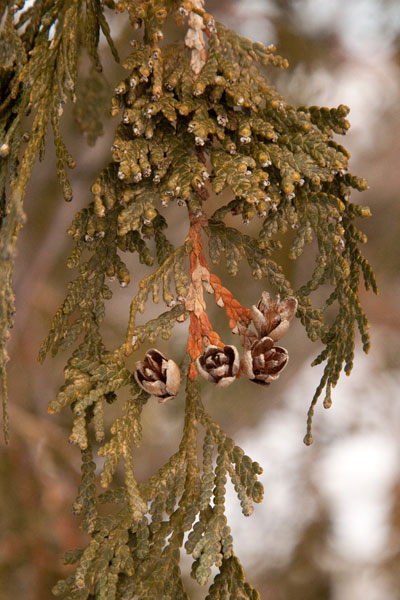
Northern whitecedar. February 7, 2010.

Northern whitecedar. February 7, 2010.
The leaves of Thuja
are "decussate," meaning that they are arranged leaves in opposite
pairs that
are perpendicular to one another. A further distinction is that the
upper and lower leaves are flat, but the lateral ones are folded over,
clasping the upper and lower ones. It reminds me of someone holding a
big hamburger with both hands.
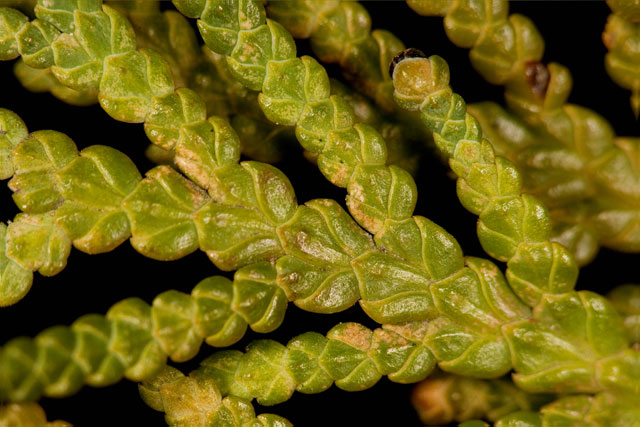
Northern whitecedar leaves are scale-like and in overlapping pairs.

Northern whitecedar leaves are scale-like and in overlapping pairs.
Juniper, Juniperus virginiana, also called
eastern redcedar (deliberately
spelled as one word because it's
really a cypress, not a cedar) is an extremely common and abundant
conifer, especially in areas with calcareous soil. It has a
distinctively dark pyrimidal form, commonly seen scattered in old
fields, where it is a pioneer in secondary succession.
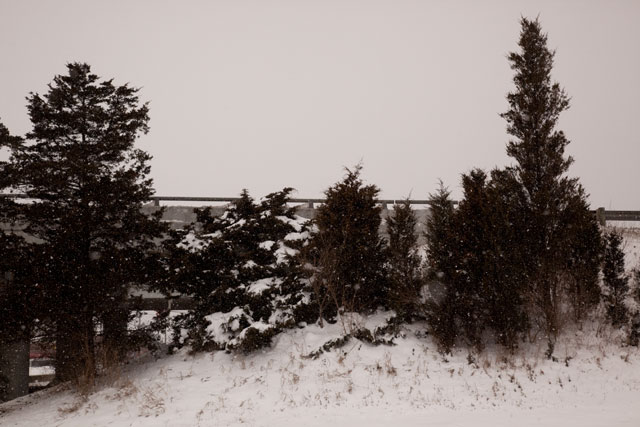
Eastern redcedar. Marion, Ohio. February 15, 2010.

Eastern redcedar. Marion, Ohio. February 15, 2010.
Unlike
most other conifers,
which are monoecious, junipers are dioecious, i.e., having separate
male and female individuals. The females bear highly modified cones
that, having fleshy and fused scales, look quite berry-like. The
"berries" of J. communis
(common juniper, a shrubby species that occurs in Ohio, but is actually
not very common) constitute
the principal flavoring used in making gin. The word "gin" is derived
from a modification of a French or Dutch word for "juniper." They are
an important winter food source for many songbirds, including cedar
waxwings.
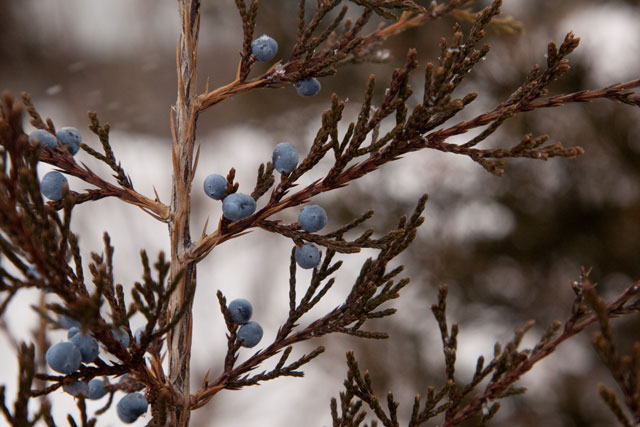
Female redcedar bearing berry-like seed cones, February 15, 2010.

Female redcedar bearing berry-like seed cones, February 15, 2010.
Eastern redcedar displays
considerable variability in its foliage, often with both types on the
same tree. The tiny scale-like leaves may either spread out from the
twigs, or instead lay appressed against the twigs in the manner of Thuja. Here's a spreading-leaved
sample.
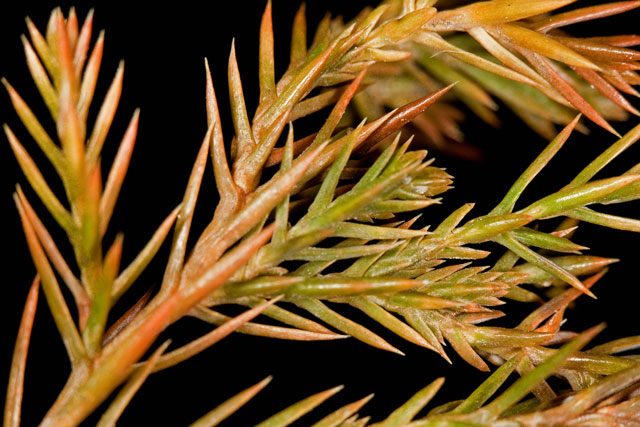
Eastern redcedar twig showing spreading-leaved form.

Eastern redcedar twig showing spreading-leaved form.
...and here's an appressed
one.
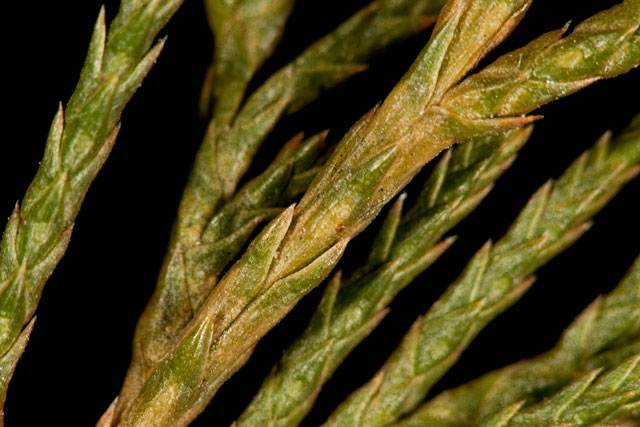
Eastern redcedar twig showing appressed-leaved form.

Eastern redcedar twig showing appressed-leaved form.
Part
3: Taxaceae, the Yew Family.
One local evergreen
conifer
doesn't produce cones. Taxus
(yew, in the family Taxaceae) seeds are instead borne singly and
look very berry-like, as they are provided with a fleshy covering
at maturity. The fleshy part, a highly modified seed cone scale, is the
only part of the plant that is non-toxic. Here's what a yew seed looked
like in mid-summer several years ago. This is one of several very
commonly planted ornamental Taxus
species, perhaps English yew (T.
baccata) or some Asian species. The native yew, T. canadensis,
is an uncommon shrub in the understory of rich deciduous and mixed
deciduous-conifer woods, occuring mainly in the northeastern portion of
the state.
Yew is indeed a gymnosperm (i.e., "naked-seeded") plant. Note that the
seed is not enclosed by this fruity-looking structure; it is
merely surrounded by it.
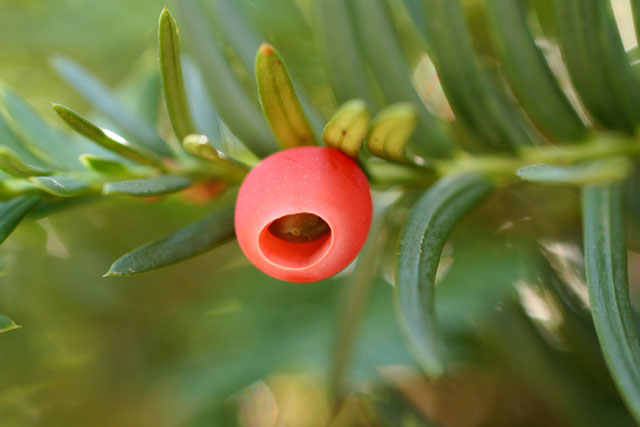
Midsummer yew seed. July 31, 2005. Columbus, Ohio.
Midwinter Fungi
Jan.-Feb., 2010

Midsummer yew seed. July 31, 2005. Columbus, Ohio.
Currently, the yew shrub
seems a
little more concerned with survival than reproduction.
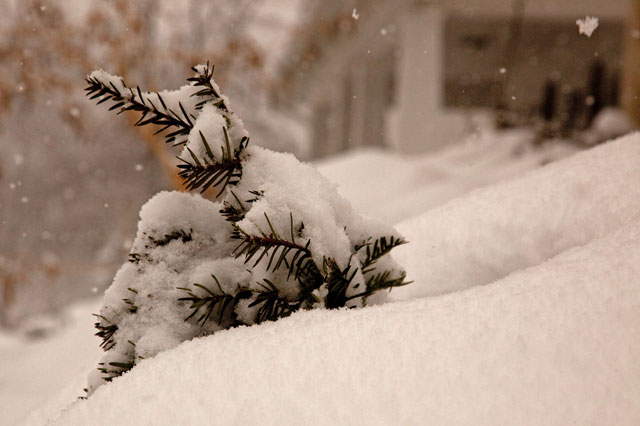
Yew shrub. February 15, 2010. Columbus. Ohio.

Yew shrub. February 15, 2010. Columbus. Ohio.
The Playboy Mansion is
being
redecorated. The interior designer decided it would be nice to employ
paint colors exactly
matching those found on Mr. Hefner's favorite plant, if only it could
be determined what that plant was. The designer, as luck would have it,
was a pretty woman who decided to ask "Hef" for the name of his
favorite plant. Expecting
professionalism even from a well-known "womanizer," she was
taken aback when he said "I love yew." Consequently she went to
the gardener to find out what plant to sample the colors from, for the
paint formulation. The gardener's advice was simple: "Use Hugh's yew's
hues."
Yew leaves are flat, and arranged in flat sprays much like eastern hemlock.
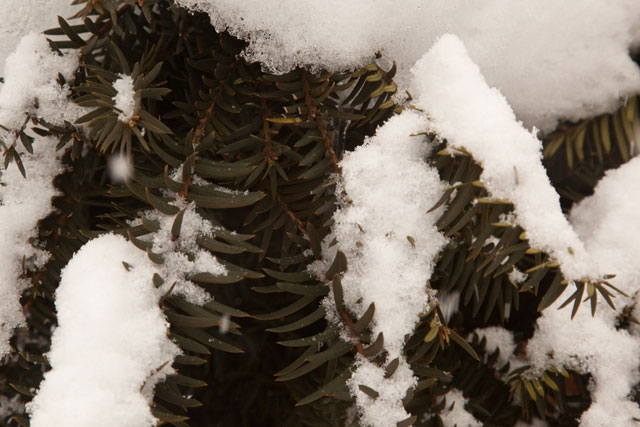
Yew shrub. February 15, 2010. Columbus Ohio.
Yew leaves are flat, and arranged in flat sprays much like eastern hemlock.

Yew shrub. February 15, 2010. Columbus Ohio.
Closeup, beneath, note
that yew
leaves bear two broad bands of stomates. The overall color is uniform,
not white-striped as eastern hemlock.
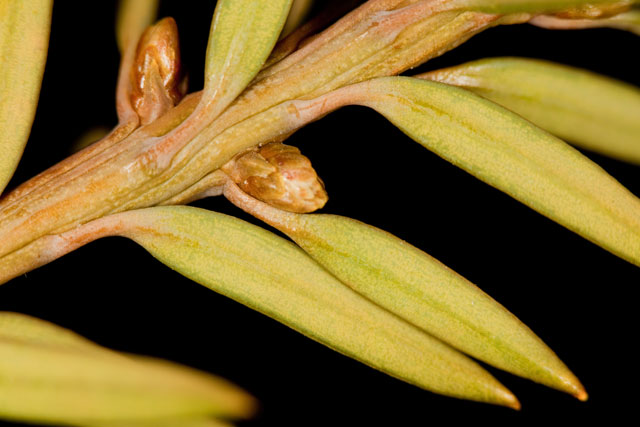
Yew leaves are uniformly colored beneath.

Yew leaves are uniformly colored beneath.
Midwinter Fungi
Jan.-Feb., 2010
Perhaps
the
most magnificant thing
that nature ever selected, the "shotgun fungus," Pilobolus
grows on the dung of grass-grazing mammals, including horses, cows and
sheep. It's a member of the group of fungi called "zygomycetes" (Class
Zygomycota). Zygomycetes are distinguished by having a coenocytic
(multinucleate) mycelium (the threads that comprise the body of a
fungus) from which extend upward, either as a result of a
sexual or an
asexual process, elongate swollen-tipped stalks, each topped by a case
of spores, a sporangium.
To experience Pilobolus, simply ask a farmer for a few dollops of sheep (or horse, or cow) poop. It helps if you provide her/him a container, such as a lettuce crisper, or a piece of "Tupperware." Let the poo sit, covered so that it stays moist, for a few days, then lift the lid and behold such extreme wonderfulness that redwoods, pandas and whales will hang their heads dejectedly upon the sudden realization that they are so enormously out-classed.
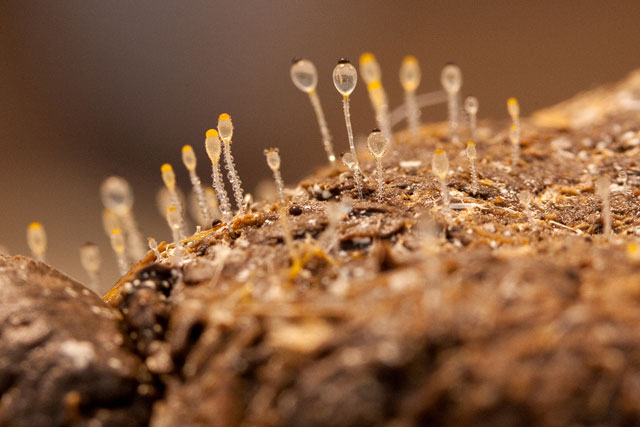
Pilobolus adorns ovine dropping brought in from the barn. February 2, 2010.
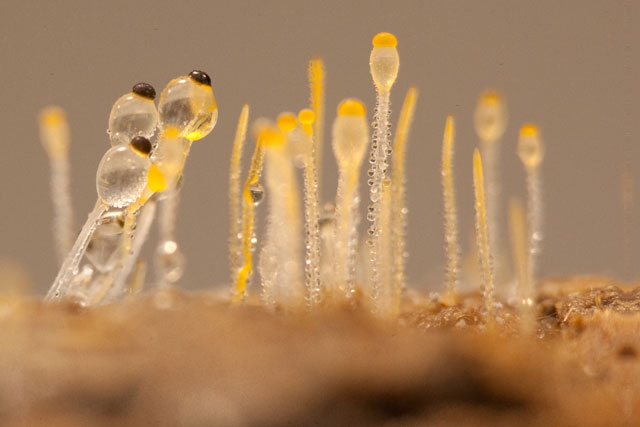
Pilobolus, the hat-tossing" fungus, orients towards the rising sun and shoots spores away from home.
To experience Pilobolus, simply ask a farmer for a few dollops of sheep (or horse, or cow) poop. It helps if you provide her/him a container, such as a lettuce crisper, or a piece of "Tupperware." Let the poo sit, covered so that it stays moist, for a few days, then lift the lid and behold such extreme wonderfulness that redwoods, pandas and whales will hang their heads dejectedly upon the sudden realization that they are so enormously out-classed.

Pilobolus adorns ovine dropping brought in from the barn. February 2, 2010.
Pilobolus is
neatly adapted for moving from one dung-patty to another. The
swollen top of the sporangium-producing stalk (sporangiophore) is
transparent and functions as a lens, enabling the sporangiophore to
position itself at a low
angle by pointing towards the rising sun. In this way the
spores
(packed together into the dark compressed "hat" at the very top of the
stalk) are dispersed
away from their home dung-pile when they are expelled ballistically as
much as 6 feet away. This is necessary because grazing herbivores
avoid dung as they merrily munch the nearby grass. While they munch the
grass they
also munch Pilobolus spores,
and a new generation of fungus finds itself in just the right place to
colinize (and help recycle) a new patch of dung.

Pilobolus, the hat-tossing" fungus, orients towards the rising sun and shoots spores away from home.
Another major group of
fungi are
the basidiomycetes, sometimes called "club fungi," in the Class
Basidiomycota. This group includes mushrooms, one species of which is
quite tiny, and grows from crevices in the bark of a sweetgum tree in
front of my house. Photographing the mushroom is much more interesting
than shoveling snow. I think this is Mycena
corticola.
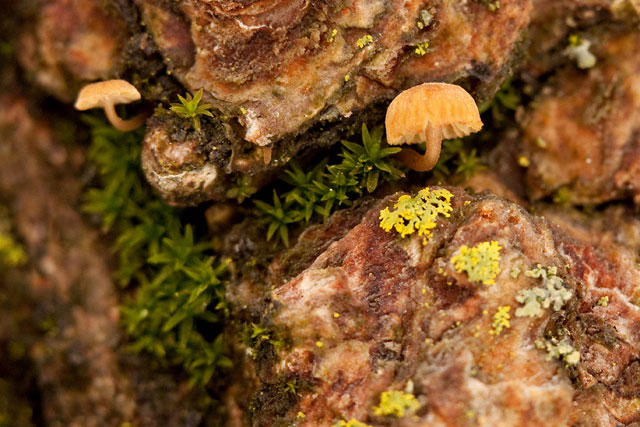
The tiny "bark mycena" (Mycena corticola) mushroom, Orthotrichum pumilum moss
and Candelaria concolor lichen growing on an urban sweetgum tree. February 6, 2010. Columbus, Ohio.

The tiny "bark mycena" (Mycena corticola) mushroom, Orthotrichum pumilum moss
and Candelaria concolor lichen growing on an urban sweetgum tree. February 6, 2010. Columbus, Ohio.
Lichens are well known
symbiotic
dual organisms --an alga and a fungus. But they're really mostly
fungus, and
often display the characteristic fungal spore-producing structures
--usually ascocarps
--of their group, usually the sac fungi (Class Ascomycota). Here's Physcia millegrana
growing on the bark of an American sycamore tree alongside the Scioto
River in Columbus, Ohio. This is a narrow-lobed light gray foliose
lichen that has fluffy-looking edges owing to its abundant marginal
soredia --powdery granules containing both fungal hyphae and alga cells
that break away from the lichen, enabling dispersal and reproduction.
Note also the cup-shaped apothecia --fungal reproductive structures
lined with microscopic spore-producing sacs (asci). Growing with the
gray Physcia is a very common
associate found even on roadside trees
in urban areas, the bright yellow Candelara
concolor.
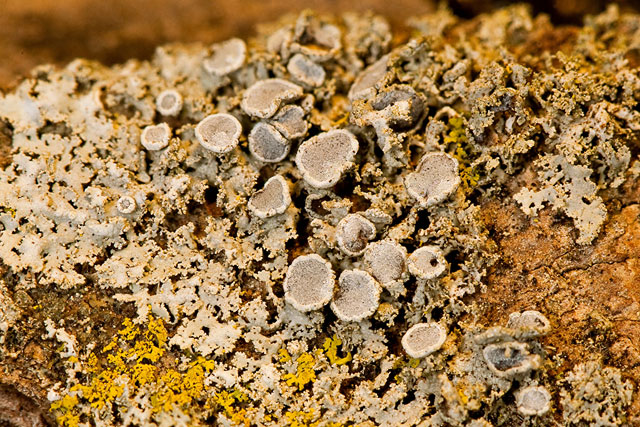
Physcia millegrana.

Physcia millegrana.
Here's a little more Candelaria
concolor, along with Tortula
papillosa (family Pottiaceae) moss and a sycamore lace bug
insect.
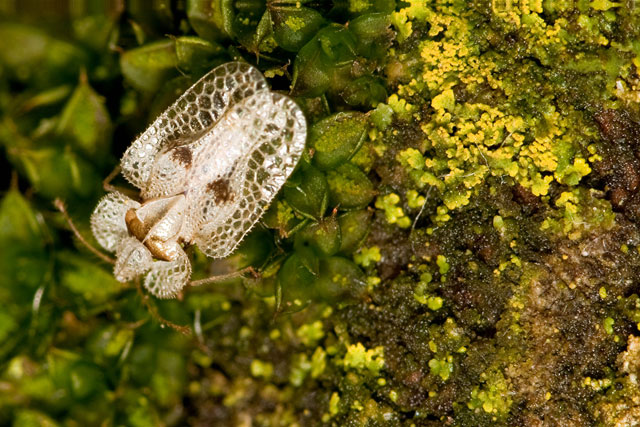
Moss, bug and lichen. January 21, 2010. Columbus, Ohio.
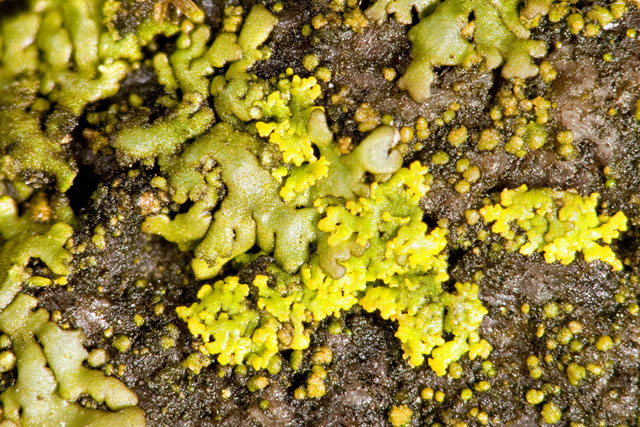
Foliose lichens on rock.

Moss, bug and lichen. January 21, 2010. Columbus, Ohio.
On
a rock in a wooded area alongside the Scioto River, some quite small
lichens are growing. One of these is a grayish-brown foliose one with
narrow lobes. It's Phaeophyscia
adiastola, mingling with Candelaria.

Foliose lichens on rock.
A couple other small
lichens are
"crustose" one. i.e., species lacking a lower layer (cortex) and that
are so tightly adherent to the substrate that it is nearly imposssible
to separate the lichen from it. This one, Caloplaca sideritis, bears abundant
apothecia (cup-shaped ascocarps).
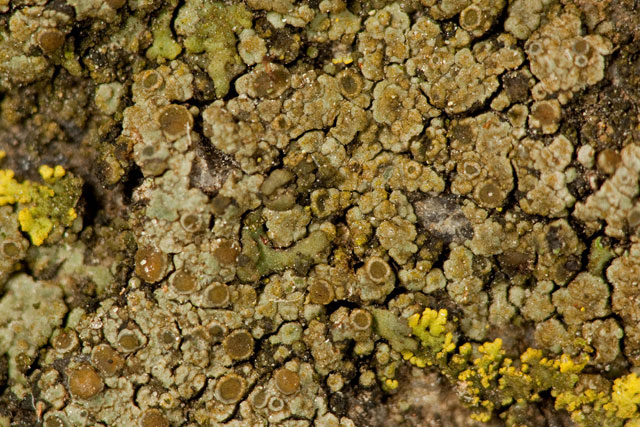
The crustose lichen Caloplaca sideritis on rock.

The crustose lichen Caloplaca sideritis on rock.
Another crustose
lichen sharing rocky real estate with Caloplaca
is even less conspicuous because its ascocarps are of a type
called "perithecia," that are flask-shaped and sunken deep within the
tissues of the lichen. All that are visible are the perithecia necks,
seen as
scattered black spots on the surface of the lichen, Endocarpon pallidum. Note also an Orthotrichum moss, and a bit more
of the foliose Phaeophyscia.
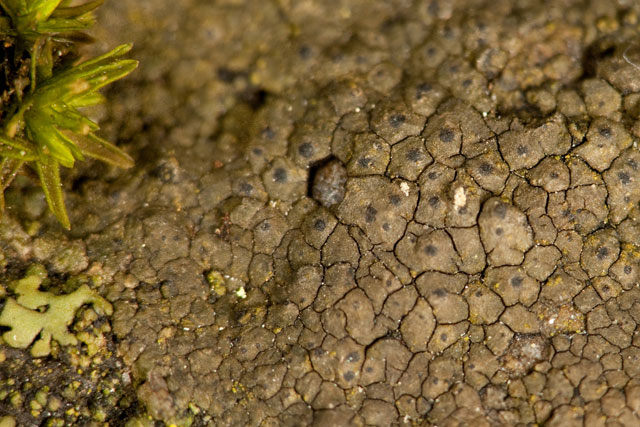
The crustose lichen Endocarpon pallidum.

The crustose lichen Endocarpon pallidum.

